
CHAMPIONS League QUARTER FINAL FIRST LEG, APRIL 8 2025
Rice (58, 70)
Merino (75)
Arsenal – and in particular Declan Rice – stunned the holders Real Madrid in this Champions League quarter final first leg. Rice scored two exceptional free-kicks in quick succession, having never previously scored from a set-piece in 338 career games. Minutes later, he burst forward to instigate an attack that led to Mikel Merino producing his own superb finish, giving the Gunners a commanding lead to take to the Bernabéu next week.
It was no less than Mikel Arteta’s team deserved against a team accustomed to winning this trophy. And it was even more admirable, given that Arsenal were forced to play with no recognised centre-forward due to injuries, and without key centre-back Gabriel.
Scoreline aside, perhaps the most telling statistic was that Arsenal collectively covered 113.9km in this game, compared to Real Madrid’s 101.2km. Tactically, our UEFA-licensed coaches have analysed the strategies employed by both teams at the Emirates Stadium, which you can read below.
How the managers saw it
“I was very convinced because I could sense in the preparation that we were really at it,” said Arteta. “We had that belief and that trust that we could create Madrid a lot of problems. This night is about all two factors. One is the atmosphere that we created 15 minutes before kick-off; something I haven’t seen before. So playing with that energy, with that commitment, with your crowd, makes a huge difference. And then magic moments, individual moments that decide all matches – and the first two goals of Declan sum up the night.”
“It’s a tough loss,” said Carlo Ancelotti. “We weren’t expecting this. The team looked pretty good and well organised in the first half. Following the two set-piece goals, the team dropped off both mentally and physically. It was a difficult end to the game because we didn’t see the reaction we’re used to seeing from this team. The final 30 minutes were very poor. There are two assessments here: one that I was satisfied up to 0-0, and the other following the reaction to their goals, which was really poor.”
 224915212541823117183522411106597
22491521254182311718352241110659711/9
SHOTS / ON TARGET
8/3
54%
POSSESSION
46%
25
ATTACKS INTO AREA
16
2.41
EXPECTED GOALS (XG)
0.60
Madrid on the transition
Real Madrid used a 4-4-2 shape when defending, with Kylian Mbappé and Vinícius Júnior in the first line. Jude Bellingham defended wide left ahead of David Alaba, with Rodrygo supporting ahead of Federico Valverde on the visitors’ right. Eduardo Camavinga and Luka Modric completed their midfield unit.
Madrid started the game high up the pitch, but offered minimal pressing threat or quality within Arsenal’s half. As such, they soon dropped deeper as Arsenal advanced. Madrid’s midfield unit then narrowed (below) in an attempt to limit access into Arsenal’s number eights – Rice and Martin Ødegaard – as well as their false nine, Merino.
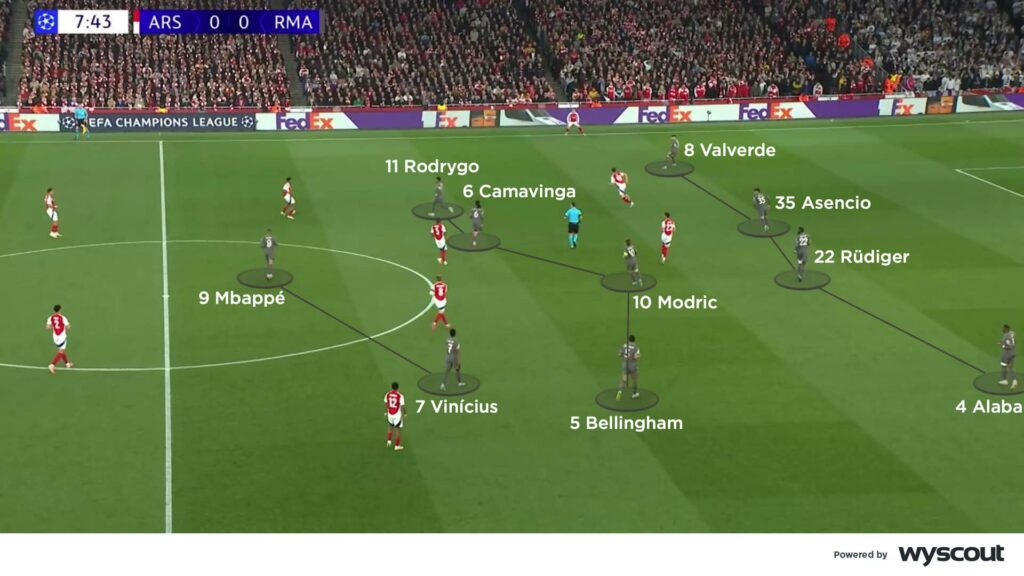
When Madrid regained possession in midfield or deeper, they had a clear plan to find Mbappé and Vinícius. The latter would instantly peel off towards Madrid’s left, aiming to attack Jurriën Timber 1v1. On this side, Alaba provided unselfish support with overlapping runs from deep, but was often ignored. Rodrygo held the width wide on the right, but he was rarely found on the counter, having come from a much deeper defensive position.
As the lone centre-forward at times, Mbappé sometimes ran beyond, but also held his ground occasionally to drive from deeper – especially if the distance between Arsenal’s midfield and centre-backs was particularly big (below). Madrid had some promising moments on the break in the first half, but typically lacked a killer final ball as Arsenal recovered. Bellingham did play Mbappé in behind with half an hour gone, but Raya saved his right-footed shot from the left side of the box.
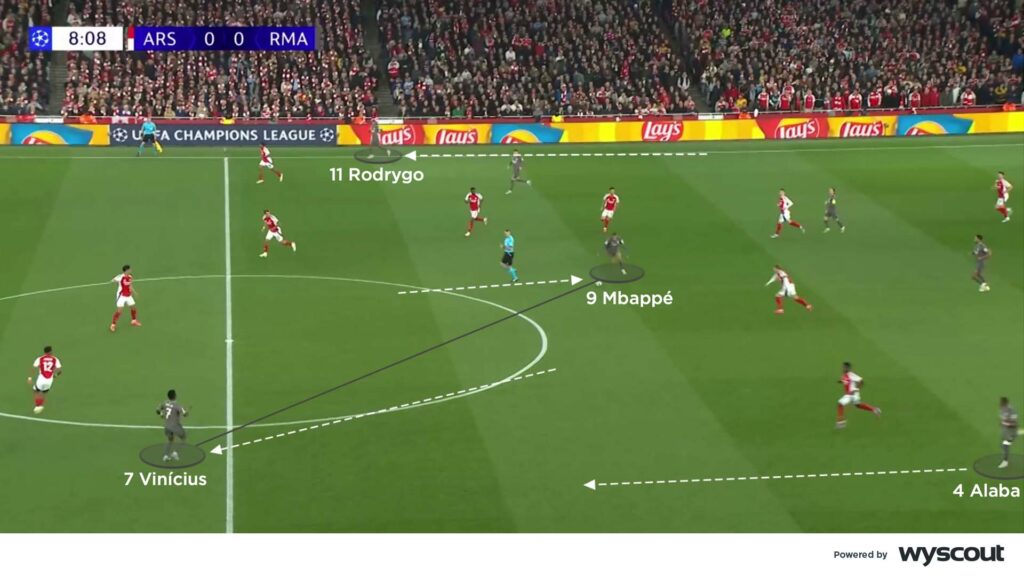
Arsenal’s wide threats
Arsenal set up in a 4-3-3, which they quickly adapted in possession to three in the back line. In build-up, Jakub Kiwior, William Saliba and Timber were able to play forward or step into midfield around Madrid’s lacklustre front pair, while left-back Myles Lewis-Skelly moved into central midfield as a second pivot alongside Thomas Partey. Rice and Ødegaard took up high positions to occupy Real Madrid’s centre-backs, as Merino often moved the other way. This created easy access into the wingers, Bukayo Saka (below) and Gabriel Martinelli, who could then attack their direct opponent by aggressively carrying the ball forward. Madrid’s midfield unit were then unsure whether to narrow and screen central access, or support defending of the wide areas.

With Arsenal’s central midfield causing Madrid’s midfield unit so many issues, the wide areas became key for the home side when they reached the final third. Their first major attacking moments came on the left, where Lewis-Skelly’s impressive receiving and forward passing – supported by Rice’s forward runs – increased access into Martinelli. Ødegaard also helped connect from between the lines, and Martinelli was able to attack Valverde 1v1, driving crosses into the penalty area for Merino and Saka to attack (below).
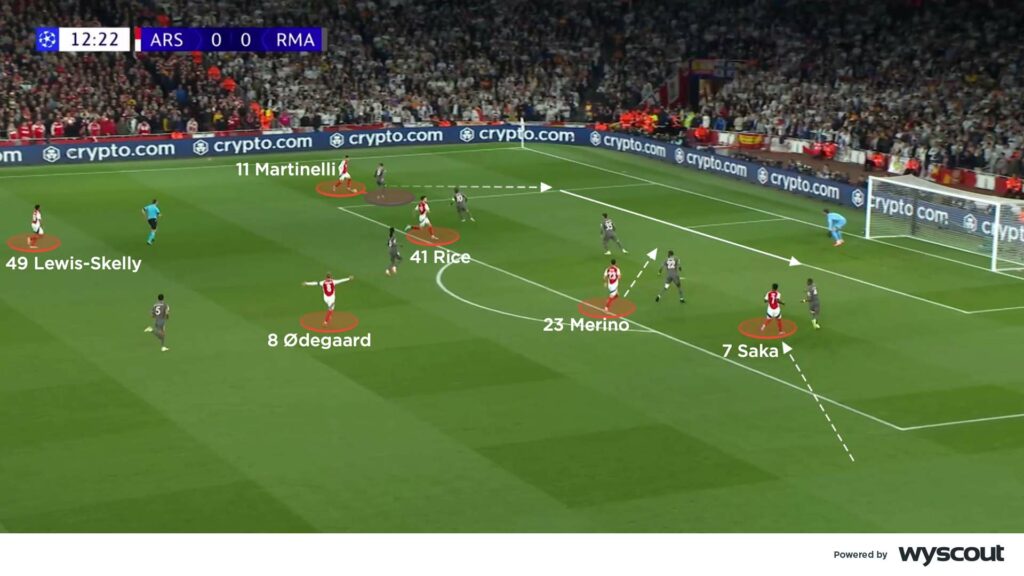
Although Arsenal’s box midfield continued to dominate, it took a little longer for a crossing threat to emerge on Saka’s side. Ødegaard dropped short and rotated with Timber almost as often as he ran forward. But when the Norwegian positioned himself higher to connect with the front line, Saka held the width for longer to receive wide or make runs in behind. From there, Arsenal’s right winger could attack 1v1 against either Alaba or the covering Bellingham (below). Saka then provided some superb driven crosses, but Arteta’s side lacked the presence of an attacker who could provide a simple touch towards goal.
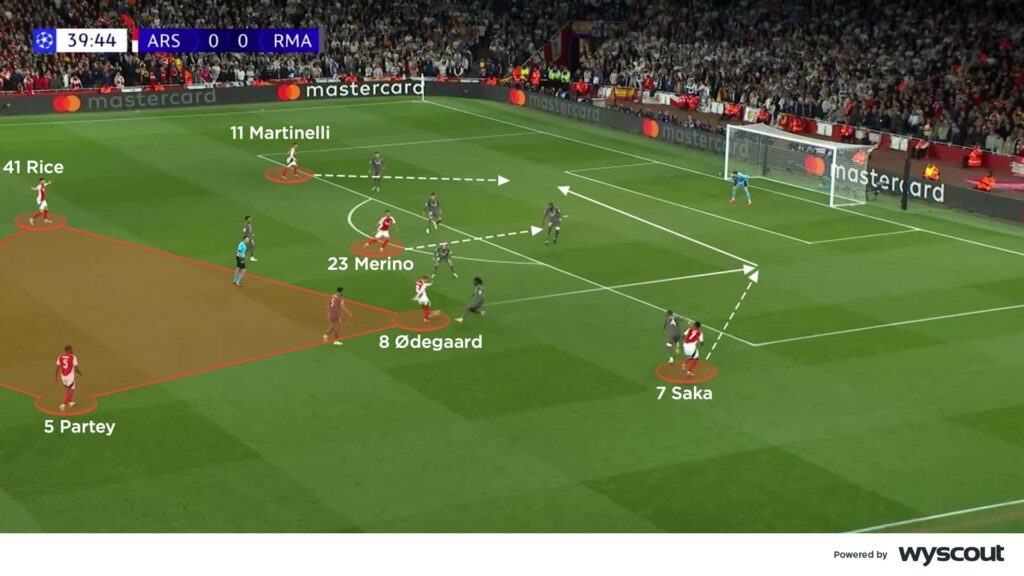
Madrid doubling up
To deal with Arsenal’s wide threats, after half-time Madrid doubled up on Saka (below) and Martinelli. This limited their crossing, almost totally nullifying the driven deliveries of the first half. But using Bellingham and Rodrygo to double up meant that Ødegaard and Rice became more influential between the lines, especially within the inside channels. Saka’s tricky dribbling – now coming back inside – also won free-kicks in dangerous areas, which Rice punished.
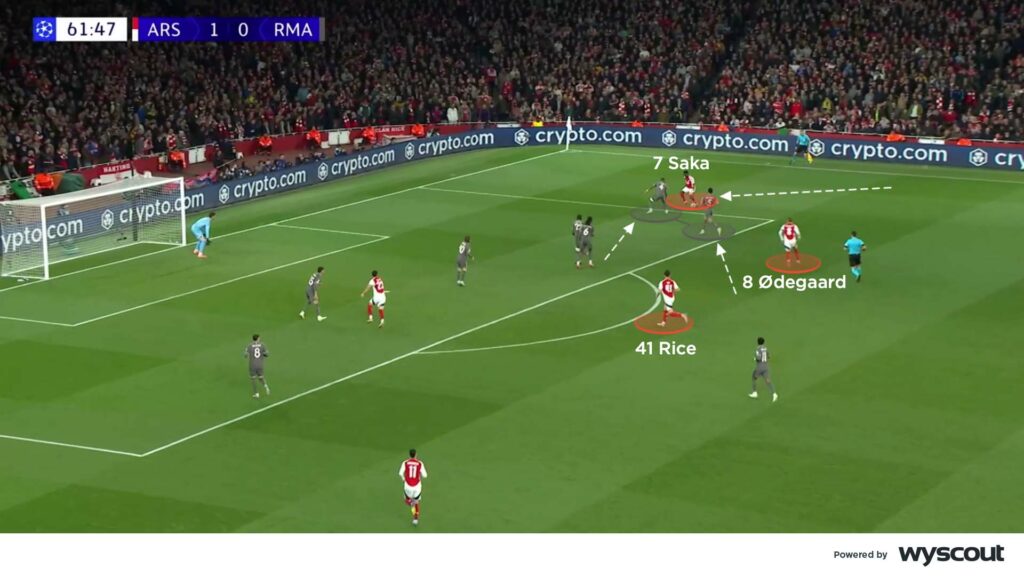
In response to Madrid’s defensive alterations, Arsenal effectively adapted their attacking combinations in the second half. With Madrid’s wide midfielders helping to double up on Martinelli and Saka, Rice and Ødegaard’s penetrative runs began to be tracked by Camavinga and Modric. This gave Arsenal’s double pivot, Partey and Lewis-Skelly, extra time on the ball. When Merino dropping occupied one of Madrid’s central midfield, it led to Rice in particular finding spaces to receive in the left inside channel (below). And it was connections on this side – with Lewis-Skelly inverting, Rice running forward, and Merino between the lines – that ended up combining for the third goal.
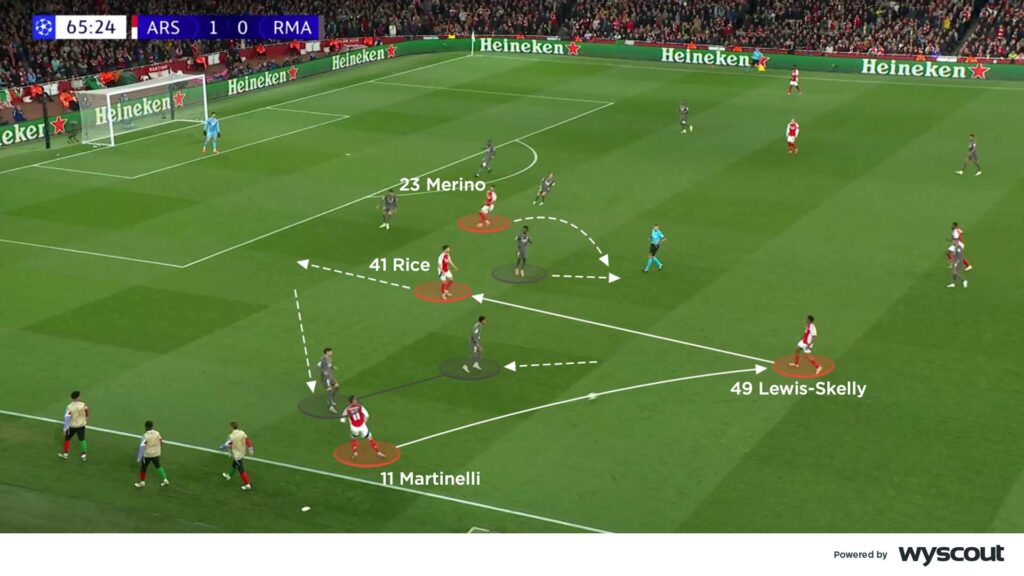
Not since 1975 have Real Madrid overturned a three-goal first-leg deficit in Europe’s premier club competition. On that occasion, they lost 4-1 to the champions of England, Derby County, before winning 5-1 at the Bernabéu in the return. Given their remarkable record in the Champions League, it would seem that if any club can overturn such a daunting lead, it would be Real Madrid. But under Mikel Arteta’s management, Arsenal are a tough nut to crack. Given this tremendous performance and result in north London, they will be confident they can do enough in Spain to reach the semi finals.
To learn more about football tactics and gain insights from coaches at the top of the game, visit CV Academy


